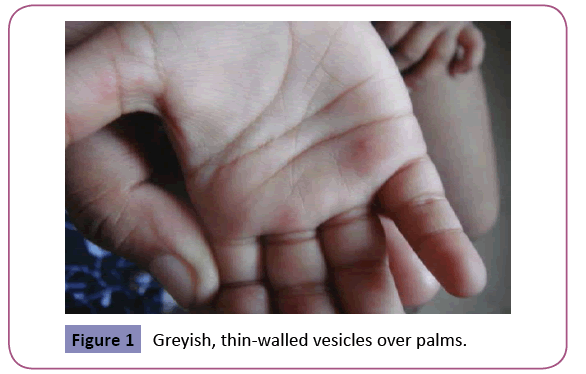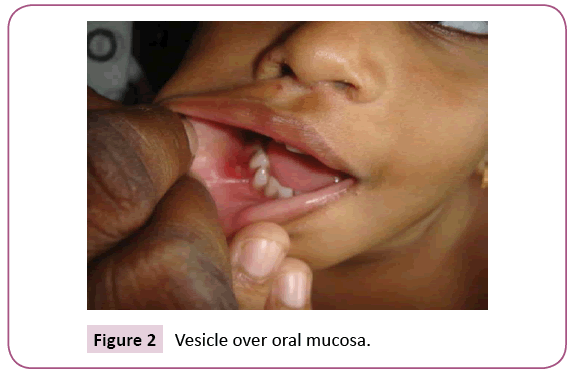Vindhya R and Narasimhalu CRV*
Department of Dermatology Venereology and Leprosy, Saveetha Medical College, Saveetha University, Thandalam, Chennai, Tamil Nadu, India
- *Corresponding Author:
- Narasimhalu CRV
Department of Dermatology Venereology and Leprosy, Saveetha Medical College, Saveetha University, Thandalam-602 105, Chennai, Tamil Nadu
E-mail: drnarasimhalu@saiskinclinic.in
Received Date: January 20, 2016; Accepted Date: February 15, 2016; Published Date: February 20, 2016
Citation: Vindhya R, Narasimhalu CRV. Vesicular Palmoplantar Eruption in a 5 Year Old Child. Clin Pediatr Dermatol. 2016, 2:1 Doi: 10.21767/2472-0143.100012
Hand, foot and mouth disease is a disease of young children but occasionally affects the adults. It usually presents with painful stomatitis caused by oral ulcers, malaise and fever. Few thin walled vesicles with narrow red areola are seen over palms and soles. This case report describes about a 5 year old female child presenting with vesicular lesions over the hands, feet and oral mucosa. The contagious nature of the disease is threatening as the disease primarily affects the children of school going age. Misdiagnosis may involve an inappropriate prescription of medication. Hence awareness of the disease entity is of vital importance amongst the dermatologists, pediatricians, general physicians and dentists, so as to alleviate the suffering of the patient.
Keywords
Hand disease; Foot disease; Mouth disease; Coxsackie virus; Red areola
Introduction
Hand, foot and mouth disease (HFMD) is a highly infectious disease characterized by multiple vesicles on the hands and feet and in the oral cavity. It is usually associated with Coxsackie virus type A 16, but sometimes A5 and A10 can also be involved. Usually presents with oral aphthous ulcers with mild fever. Later with scattered thin walled vesicles with narrow red areolae on palms and soles. There is every possibility of missing the individual cases and even small sized epidemics, due to the rarity of the cases, lack of suspicion among clinicians and similarity to common skin diseases. Simultaneous oral and cutaneous lesions have rarely been reported.
Case Report
A 5 year old female child was referred to our outpatient department with complaints of reddish skin lesions over hands and feet of 2 days duration. Patient had history of low grade fever for the past two days. No other constitutional symptoms. On clinical examination, multiple, greyish, thin-walled vesicles were present over palms (Figure 1) and soles. Examination of the oral cavity also revealed similar lesions over oral mucosa (Figure 2). No other systems were involved. Routine investigations did not reveal any abnormalities except a raised ESR (erythrocyte sedimentation rate). The diagnosis of Hand, foot and mouth disease was made based on the history as well as typical clinical findings including typical location and distribution of skin lesions.
Figure 1: Greyish, thin-walled vesicles over palms.
Figure 2: Vesicle over oral mucosa.
Discussion
Hand, foot and mouth disease was initially described by Alsop in Toronto in 1957 [1-3]. It is usually associated with coxsackie virus type A 16, but sometimes A5 and A10 can also be involved. More commonly children are affected [4] rarely adults get infected. It has occurred in epidemic form in many parts of the world [5] Infection is usually mild, lasting for about a week. It has an incubation period of 5-7 days. It presents as painful stomatitis with mild fever. Multiple oral vesicles are seen, which are comparatively larger than the oral apthous ulcer. They are few in number and rapidly ulcerate. Oral vesicles are seen over the buccal mucosa, palate, gums and tongue. Skin lesions are inconstant but when present they may be characteristic. They are thin walled vesicles up to 05 mm in diameter, with a narrow red areola, oval or linear rather than rounded. Most common on the palms and soles especially on the flexures, sides and the dorsa of the fingers and toes. In some infants there may be a more extensive exanthema, papular or vesicular, favoring the buttocks but sometimes generalized. Relapses are rare. Complications include hyperglycemia, encephalitis [6], meningitis, pulmonary edema, myocarditis, paralysis and Guillian-Barre syndrome [7]. Coxsackie virus can be cultured in suckling mice. If definitive diagnosis is required, and then the Coxsackie virus A16 and Enterovirus 71 virus can be isolated from the patients in the following media containing cell lines such as human rhabdosarcoma cells, African green monkey kidney cells (Verocells) and suckling mice. For virus identification and serological analysis, neutralization test, reverse transcription-polymerase chain reaction (RT-PCR), sequencing, and immunofluorescence assay can be used to identify the viruses and antibodies against the viruses in clinical specimens [8-10]. As the condition is self limiting, treatment is only supportive. Symptomatic therapy is to be given to control the disease spread and to control the complications.
References
- Alsop J, Flewett TH, Foster JR (1960) Hand-foot-and-mouth disease in Birmingham in 1959. British medical journal2: 1708.
- Bowles NE, Sewry CA, Dubowitz V, Archard LC (1987) Dermatomyositis, polymyositis, and Coxsackie-B-virus infection. The Lancet329: 1004-1007.
- Waldfahrer F, Iro H (1995) Letters to the editor: Successful treatment of herpangina with allopurinol mouthwashes. The Laryngoscope105: 1405-1405.
- Jennifer C, Haley A, Antoinette F (2015) Hood, Hand-Foot-and-Mouth Disease. Fitzpatrick’s Dermatology in General Medicine.
- Goh KT, Doraisingham S, Tan JL, Lim GN, Chew SE (1982) An outbreak of hand, foot, and mouth disease in Singapore. Bulletin of the World Health Organization60: 965.
- Conway SP (1987) Coxsackie B2 virus causing simultaneous hand, foot and mouth disease and encephalitis. Journal of Infection15: 191.
- Sterling JC (2013) Virus infections. Chapter 25.7thedn. Rook’s textbook of Dermatology.
- World Health Organization (2011) A guide to clinical management and public health response for hand, foot and mouth disease (HFMD). Manila: WHO Regional Office for the Western Pacific.
- Keawcharoen J (2012) Hand, Foot and Mouth Disease. Thai J Vet Med42: 255-257.
- Sarma N, Sarkar A, Mukherjee A, Ghosh A, Dhar S, et al. (2009) Epidemic of hand, foot and mouth disease in West Bengal. A multicentric study. Indian journal of dermatology54: 26.



